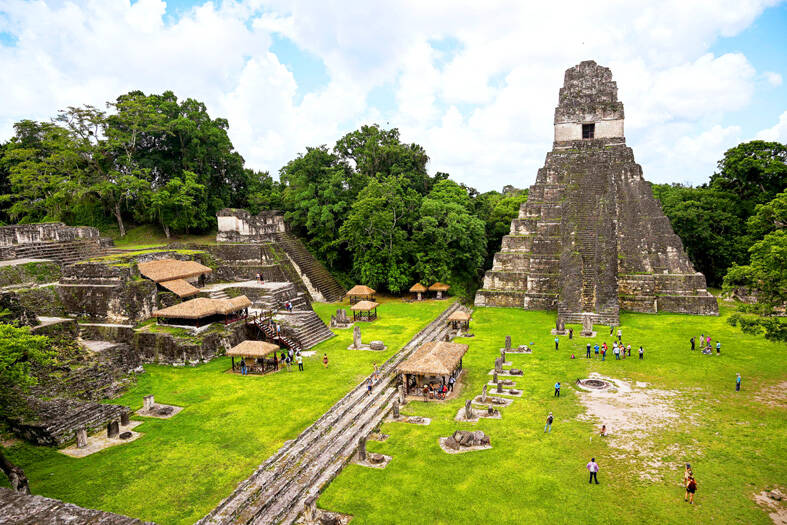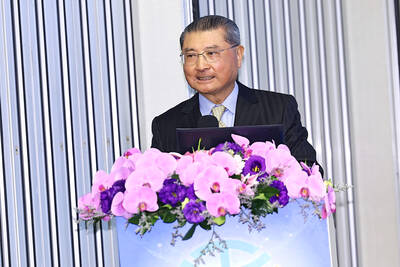In the lush jungle of northern Guatemala — in the largest protected area in Central America — 30 leaders from Colombia’s Amazon basin region are swapping strategies with local ethnic Maya farmers on how to live off this dense forest without destroying it.
Under the soaring, leafy mahogany and cedar trees in the Maya Biosphere Reserve, the visiting group discusses ways to ensure the rain forest remains healthy, while studying the reserve-type model Guatemala has been developing since 1994.
Guatemala’s vast sustainability project aims to achieve a balance in which communities reforest, cut down trees for timber in a controlled way, grow grains and vegetables, collect ornamental plants and develop low-impact tourism.

Photo: AFP
“That ensures that our communities are getting the economic resources that are also invested here for conservation,” National Council of Protected Areas (CONAP) regional director Sergio Balan said in the village of Melchor de Mencos, near the border with Belize.
The Maya Biosphere Reserve sprawls over 2.1 million hectares and borders Mexico and Belize. Every year, its flora and fauna are threatened by fires, deforestation for agricultural and livestock purposes, and even drug traffickers.
Hundreds of archeological sites are in the territory, such as the ancient Mayan city of Tikal, one of the main tourist sites in Guatemala and the site hosting the visitors from the Forest Development and Biodiversity Centers of the Colombian Amazon.
In the reserve and near Tikal is also the pre-Hispanic park of Uaxactun, where both groups participated in a Mayan ceremony with a fire stoked with candles and tree resin.
The Colombian leaders, whose visit lasted a week, highlighted the achievements in reducing deforestation in the Colombian Amazon between 2021 and last year, by 61 percent, data from the Colombian Ministry of Environment and Sustainable Development showed.
Sixteen active concessions help conserve nearly 619,000 hectares of forest, while controlled logging permits let private companies work for 25 or 30-year periods, CONAP says.
Concessions and reserves “not only provide employment, but also training for different jobs,” said Erwin Maas, a Guatemalan tourist guide who is also familiar with forestry.
CONAP said that the concessions, a kind of activity grant, create about 150,000 direct and indirect jobs in the reserve.
Along one part of the path, visitors find a row of cut logs that are stacked to be taken to the sawmill. The wood comes from trees selected for felling in a controlled process that will allow the forest to regenerate.
Nearby, the sound of birds and monkeys fluttering through the branches, mixes with group’s chatter.
“One of the great ideas we took away is the form of organization they have had [in Guatemala] to really last over time,” said Aristides Oime, president of a Colombian farm group, Asojuntas de Cartagena del Chaira.
“From farmer to farmer, we see how we can really improve,” he said. “We want to show how we truly believe that deforestation is not the way, the real route is environmental conservation.”
Although there are differences with the Guatemalan communities, they learned lessons about how other people control land sustainably, said Luz Rodriguez, the coordinator of the Colombia-based non-governmental organization Heart of the Amazon.

When an apartment comes up for rent in Germany’s big cities, hundreds of prospective tenants often queue down the street to view it, but the acute shortage of affordable housing is getting scant attention ahead of today’s snap general election. “Housing is one of the main problems for people, but nobody talks about it, nobody takes it seriously,” said Andreas Ibel, president of Build Europe, an association representing housing developers. Migration and the sluggish economy top the list of voters’ concerns, but analysts say housing policy fails to break through as returns on investment take time to register, making the

‘SILVER LINING’: Although the news caused TSMC to fall on the local market, an analyst said that as tariffs are not set to go into effect until April, there is still time for negotiations US President Donald Trump on Tuesday said that he would likely impose tariffs on semiconductor, automobile and pharmaceutical imports of about 25 percent, with an announcement coming as soon as April 2 in a move that would represent a dramatic widening of the US leader’s trade war. “I probably will tell you that on April 2, but it’ll be in the neighborhood of 25 percent,” Trump told reporters at his Mar-a-Lago club when asked about his plan for auto tariffs. Asked about similar levies on pharmaceutical drugs and semiconductors, the president said that “it’ll be 25 percent and higher, and it’ll

CHIP BOOM: Revenue for the semiconductor industry is set to reach US$1 trillion by 2032, opening up opportunities for the chip pacakging and testing company, it said ASE Technology Holding Co (日月光投控), the world’s largest provider of outsourced semiconductor assembly and test (OSAT) services, yesterday launched a new advanced manufacturing facility in Penang, Malaysia, aiming to meet growing demand for emerging technologies such as generative artificial intelligence (AI) applications. The US$300 million facility is a critical step in expanding ASE’s global footprint, offering an alternative for customers from the US, Europe, Japan, South Korea and China to assemble and test chips outside of Taiwan amid efforts to diversify supply chains. The plant, the company’s fifth in Malaysia, is part of a strategic expansion plan that would more than triple

Taiwanese artificial intelligence (AI) server makers are expected to make major investments in Texas in May after US President Donald Trump’s first 100 days in office and amid his rising tariff threats, Taiwan Electrical and Electronic Manufacturers’ Association (TEEMA, 台灣電子電機公會) chairman Richard Lee (李詩欽) said yesterday. The association led a delegation of seven AI server manufacturers to Washington, as well as the US states of California, Texas and New Mexico, to discuss land and tax issues, as Taiwanese firms speed up their production plans in the US with many of them seeing Texas as their top option for investment, Lee said. The